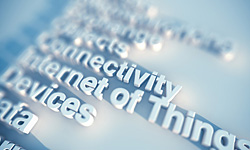Vendor Ecosystems and the IoT September 2017
Want more free featured content?
Subscribe to Insights in Brief

In May 2017, the Scan™ Pattern, Voice Assistants: Strategies and Issues, described how voice assistants are integrating into an increasing variety of IoT devices. In particular, Amazon's Alexa is available in a wide array of appliances and devices, including vacuum cleaners, light switches, ovens, refrigerators, and dishwashers. Apple and Google have also opened up their voice assistants—Siri and Google Assistant, respectively—to third parties. Voice assistants offer users a convenient way to integrate multiple smart products together and provide a common user interface for IoT devices. However, by utilizing voice assistants, manufacturers are effectively choosing to run their products on another company's software platform, increasing the value of that platform in the process and, perhaps, conferring part of the value of the IoT opportunity to the platform provider.
Vendor ecosystems could eventually become much more influential than they are today. Already, home builder KB Home (Los Angeles, California) has built a HomeKit-enabled community in San Jose, California, in which homes feature lights, locks, thermostats, and other devices that are compatible with Apple's HomeKit smart-home platform. The July 2017 Scan Pattern, Automotive Infiltration, Not Disruption, describes how Alphabet, Apple, and Microsoft (Redmond, Washington) supply automotive companies with in-car software systems, including systems that connect with cloud services. In health insurance, providers such as Aetna (Hartford, Connecticut) and Qantas Assure (Qantas Airways; Mascot, Australia) provide customers incentive to use Apple devices to track their activity levels. Software ecosystems are not specific to consumer devices. The January 2017 Scan Signal of Change, The Road to Industry 4.0, notes that GE has been aggressive in its pursuit of Industrial Internet of Things (IIoT) opportunities, buying up software companies, creating partnerships, and setting up its GE Digital division. The company hopes that its Predix platform will become the de facto standard for cloud-based IIoT services.
Although software ecosystems are sometimes convenient for users, they also tie those users to certain products and services. When selling his car, security researcher Charles Henderson, global head of IBM's (Armonk, New York) X-Force Red security-testing team, discovered that the car's connected car-management system stored data in the cloud and never forgot its original owner—even after he cleared all his personal information from the car's memory and reset the car's phone book.
If software ecosystems reach their full potential, they could have a significant impact on competition across a wide range of products and services. Plausibly, a future car buyer might be at a disadvantage if he or she buys a car that belongs to a software ecosystem that is different from the one that runs his or her home and personal devices. Future consumers might have difficulty securing insurance unless they sign up to a software ecosystem that enables the insurer to monitor their health and behavior. Perhaps entire smart communities will become dependent on certain vendors' software. In the workplace, manufacturers may struggle to take advantage of new advanced manufacturing techniques unless they run their machines and processes on a particular platform (many businesses are already familiar with such vendor lock-in in enterprise and desktop software).
Vendor lock-in is not the only competition-related challenge that software ecosystems create. The November 2015 Scan Signal of Change, The World According to Digital Assistants, discusses the challenges that companies face as digital assistants and software ecosystems mediate interactions between people and products and services. Ostensibly, digital assistants filter products and services according to user preferences, but they also filter according to the preferences and partnerships of their developers (for example, a digital assistant might default to its developer's other applications). In the future, tech firms may become gatekeepers between companies and their customers.
Regulators may step in to deal with unfair competition. Recently, the European Commission fined Google €2.42 billion ($2.7 billion at the time) for giving unfair advantage to its own comparison-shopping service in its search-engine results. Future lawsuits may impose further competition-driven restrictions on software ecosystems. Although such rulings could protect some firms, they may be misguided and have unforeseen consequences. Indeed, the Washington Post has argued that government lawyers sometimes lack the technical understanding to deal effectively with cases about internet technology.
The rise of vendor ecosystems is not a forgone conclusion. Various efforts to improve interoperability among IoT devices are under way, and an open Web of Things may yet develop. For example, the Open Connectivity Foundation (Beaverton, Oregon), which formed in early 2016, brings together two previously competing groups: the Open Interconnect Consortium (Beaverton, Oregon) and the AllSeen Alliance (Chandler, Arizona). The foundation's lead members include Cisco Systems (San Jose, California), Intel Corporation (Santa Clara, California), LG Corporation (Seoul, South Korea), Microsoft, Qualcomm (San Diego, California), and Samsung (Seoul, South Korea).
In general, however, vendor ecosystems are progressing faster than standards efforts are progressing. Vendors have not reached consensus about standards, and some companies have vested interests in protecting proprietary ecosystems. For example, Amazon, Apple, and Google are all conspicuously absent from the Open Connectivity Foundation, despite the foundation's having more than 300 member organizations.